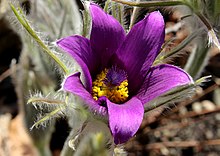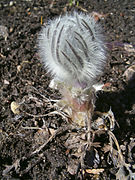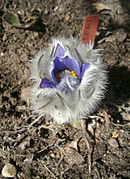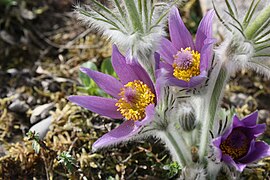Pulsatilla halleri
| Haller's anemone | |
|---|---|

| |
| Flower at the Botanical Garden of the University of Vienna | |
| Scientific classification | |
| Kingdom: | Plantae |
| Clade: | Tracheophytes |
| Clade: | Angiosperms |
| Clade: | Eudicots |
| Order: | Ranunculales |
| Family: | Ranunculaceae |
| Genus: | Pulsatilla |
| Species: | P. halleri |
| Binomial name | |
| Pulsatilla halleri (All.) Willd. | |
| Synonyms[2] | |
|
Of the species:
| |
Pulsatilla halleri, synonym Anemone halleri,[2] Haller's anemone, is a species of flowering plant in the buttercup family Ranunculaceae, that can be found in sub-alpine and alpine regions of southern France, southern Switzerland, northern Italy and Poland, extending eastward to Greece, Bulgaria and Ukraine. It is found in mountain meadows, dry hills, dry grassy locations and mountainous forest glades. It is collected and cultivated for botanical and private gardens.
Growing in clumps to 20 cm (7.9 in) tall and wide, this herbaceous perennial has hairy grey-green foliage, and in spring produces pink or purple flowers which form ornamental silky seedheads. It prefers an exposed, well-drained position in full sun. [3]
Anemone halleri is mildly toxic, and can cause stomach ache on skin contact.[3]
The species and the subspecies P. halleri subsp. slavica are recipients of the Royal Horticultural Society's Award of Garden Merit.[3][4]
References
- ^ Schweizer, F.; Hasinger, O. (2014). "Anemone halleri". IUCN Red List of Threatened Species. 2014: e.T202925A2758051. doi:10.2305/IUCN.UK.2014-1.RLTS.T202925A2758051.en. Retrieved 20 November 2021.
- ^ a b "Pulsatilla halleri (All.) Willd." Plants of the World Online. Royal Botanic Gardens, Kew. Retrieved 2024-03-25.
- ^ a b c "Pulsatilla halleri". www.rhs.org. Royal Horticultural Society. Retrieved 17 February 2021.
- ^ "Pulsatilla halleri subsp. slavica". RHS. Retrieved 12 April 2020.




